Physical Address
304 North Cardinal St.
Dorchester Center, MA 02124
Accurate diagnosis of salivary gland disorders depends on a thorough history and a good physical examination.
Although most salivary gland lesions in children have an inflammatory etiology, the differential diagnosis is vast and includes acute or chronic inflammatory and/or infectious conditions, congenital lesions, vascular malformations, benign or malignant tumors, traumatic injury, and many systemic diseases.
Common bacterial etiologies of sialadenitis include Staphylococcus aureus and anaerobes. Viral etiologies include paramyxovirus (mumps), Epstein-Barr virus, cytomegalovirus, parainfluenza virus, adenovirus, coxsackievirus, and human immunodeficiency virus.
Hemangiomas are the most frequently encountered benign tumors in the parotid area, and pleomorphic adenomas are the most common benign intrinsic parotid tumors.
Salivary gland neoplasms are more likely to be malignant in children than in adults, with the parotid gland being the most common site. Mucoepidermoid carcinoma is the most common salivary gland malignancy in children (>50%), whereas adenoid cystic and acinic cell carcinomas make up most of the remainder.
A solid, firm, fixed salivary mass that persists for more than 4 to 6 weeks is usually an indication for open surgical biopsy and/or excision.
Ultrasound (US) with or without fine-needle aspiration (FNA) can be useful in the diagnosis of most parotid and submandibular gland diseases in children. Cross-sectional imaging with computed tomography or magnetic resonance imaging with contrast is helpful for a thorough evaluation of the nature and extent of salivary gland masses.
Sialendoscopy is an effective minimally invasive tool for the diagnosis of salivary gland ductal pathology (e.g., inflammation, stenosis, stricture) and for the treatment of sialolithiasis and juvenile recurrent parotitis. Intraductal lithotripsy can be performed to fragment larger stones.
Sialorrhea is seen mainly in patients with neurologic disorders and is mostly caused by an inability to control oral secretions rather than an overproduction of saliva. Sialorrhea may lead to medical complications such as dermatitis, choking, aspiration, pneumonia, feeding issues, and speech problems. Excessive drooling may also cause social or psychological problems or interfere with the patient’s daily care and rehabilitation therapies, creating an additional burden on caregivers.
An individualized stepwise treatment approach for sialorrhea includes rehabilitation options (positioning, oral motor, behavior therapy), medical treatment (anticholinergics, botulinum toxin injection), ancillary surgery as required (adenoidectomy, tonsillectomy, turbinate reduction, tongue reduction), and/or salivary gland surgery (submandibular gland excision, duct ligation or duct relocation). A combination of approaches is more effective than a single treatment in many patients.
We would like to thank our colleagues Dr. Alyssa A. Kanaan for her essential contribution to the previous edition of this chapter, Dr. Jean-Yves Sichel for generously supplying some of the pictures, and Ms. Elena Guadagno for her assistance in the literature search.
Salivary gland disorders remain an uncommon entity in the pediatric population but are not infrequently seen in a pediatric otolaryngology practice. The differential diagnosis includes acute or chronic inflammatory and/or infectious conditions, congenital lesions, vascular malformations, benign or malignant tumors, traumatic injury, and many systemic diseases ( Box 24.1 ).
Bacterial: ( Staphylococcus aureus, Streptococcus viridans, anaerobes)
Viral:
(Mumps
EBV
HIV
Coxsackievirus A
Echovirus
CMV
Parainfluenza
Adenovirus)
Obstructive
Mucocele/ranula
Sialolithiasis
Sialectasis
Granulomatous
Atypical mycobacteria
Cat-scratch disease
Actinomycosis
Sarcoidosis
Toxoplasmosis
Histoplasmosis
Agenesis
Branchial cleft cyst or fistula
Dermoid
Ductal cyst
Ranula (can also be congenital)
Pleomorphic adenoma
Warthin tumor
Lipoma
Monomorphic adenoma
Neurofibroma
Primary
Mucoepidermoid carcinoma
Acinic cell carcinoma
Adenocarcinoma
Adenoid cystic carcinoma
Lymphoma
Rhabdomyosarcoma
Metastatic
Hemangioma
Lymphatic malformation
Venous anomaly
Arteriovenous malformation
Sjögren syndrome
Benign lymphoepithelial disease
Wegener granulomatosis
Sarcoidosis
Blunt
Penetrating
Radiation induced
A good history and physical examination are extremely useful in diagnosing the specific salivary gland disorder. An algorithm for the evaluation of pathology in the parotid gland, the most common salivary gland affected in children, is illustrated in Figs. 24.1 and 24.2 . Ultrasound (US), computed tomography (CT), magnetic resonance imaging (MRI), and fine-needle aspiration biopsy (FNAB) have proved valuable for a more thorough evaluation of the nature and extent of salivary gland masses. Sialendoscopy has become an indispensable tool in the diagnosis of ductal pathology such as inflammation, stenosis, and stricture and is also valuable in the management of sialolithiasis and juvenile recurrent parotitis (JRP). A comprehensive understanding of salivary gland anatomy, physiology, and function remains essential for the diagnosis and treatment of salivary gland disorders.
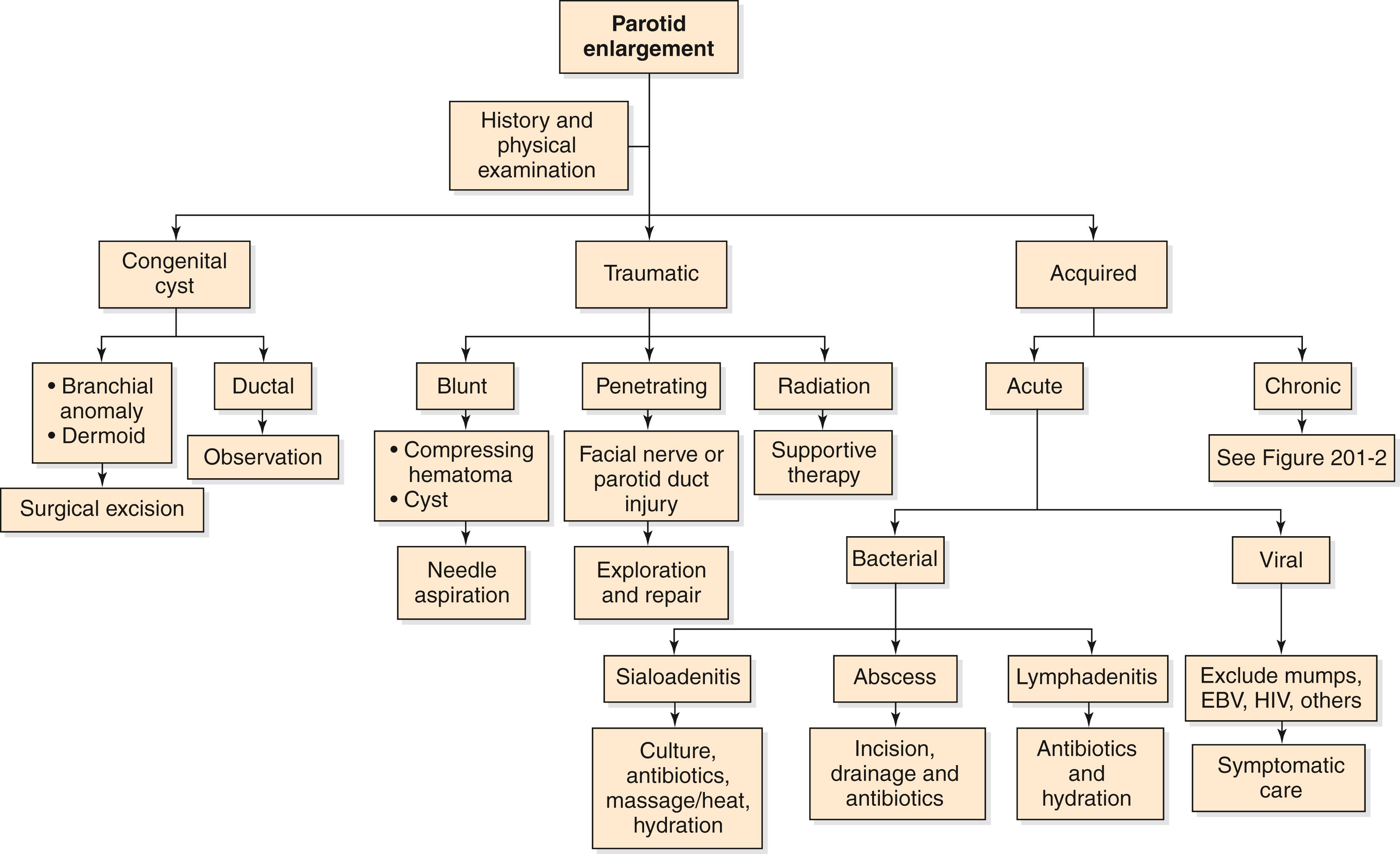
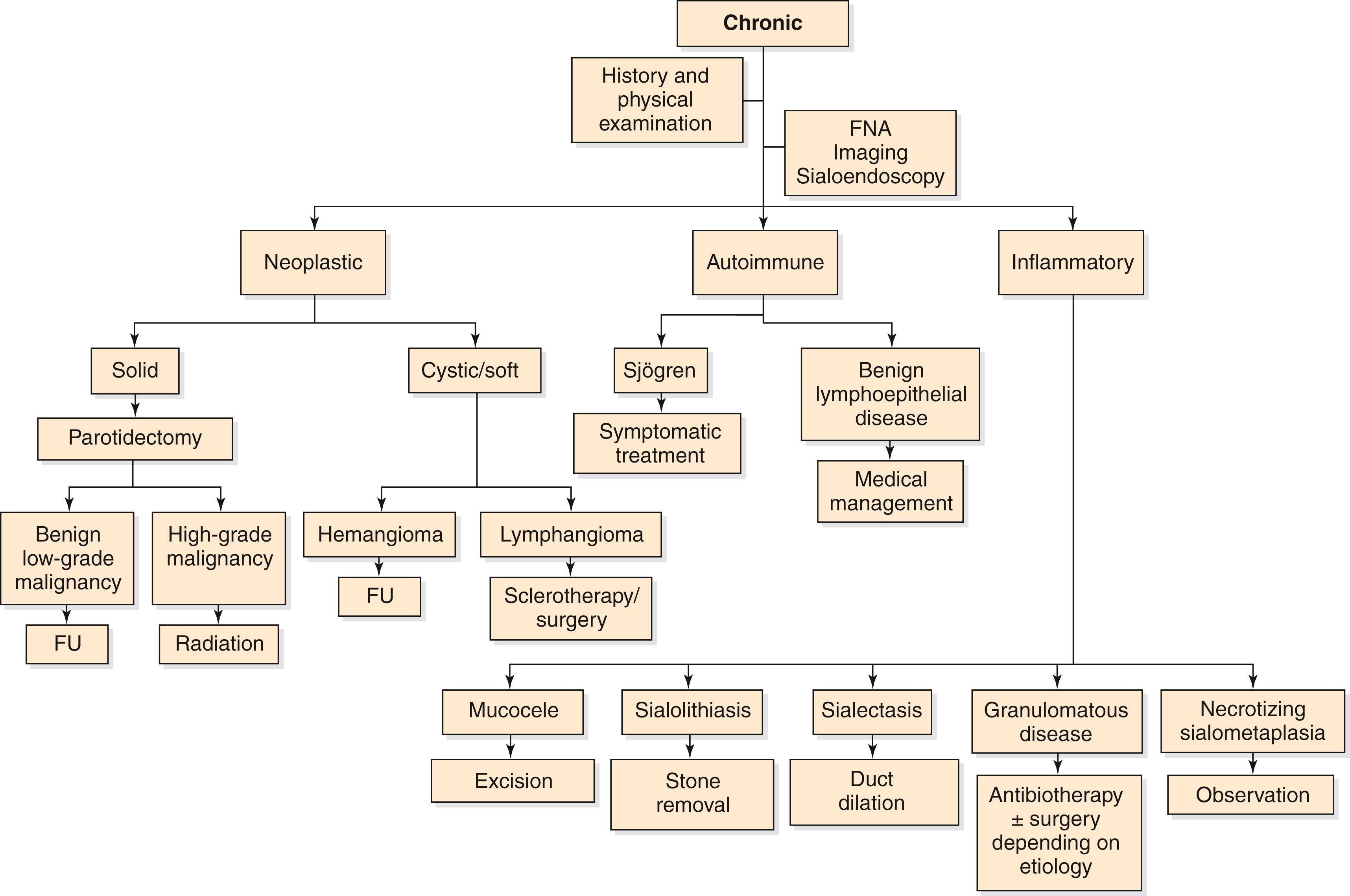
The three pairs of major salivary glands are the parotid, submandibular, and sublingual glands ( Fig. 24.3 ); there are also hundreds of minor salivary glands that are predominantly located in the palatine mucosa. All salivary glands are derivatives of ectoderm. During development, ectodermal rests pierce surrounding mesenchyme and arborize before terminating into multiple acini. Each salivary gland is an aggregate of multiple salivary secretory units composed of acini and ducts ( Fig. 24.4 ). Saliva produced by the secretory cells of the acini passes through intercalated, intralobular, and excretory ducts before collecting in the main excretory duct of the gland. The parotid gland consists mainly of serous acini that secrete a watery serous fluid. The submandibular gland is composed of a mixture of serous and mucinous acini, whereas the sublingual gland and minor salivary glands contain predominantly mucinous acini that secrete thick mucinous fluid. The primary saliva secreted is modified because it transits through the ductal system.
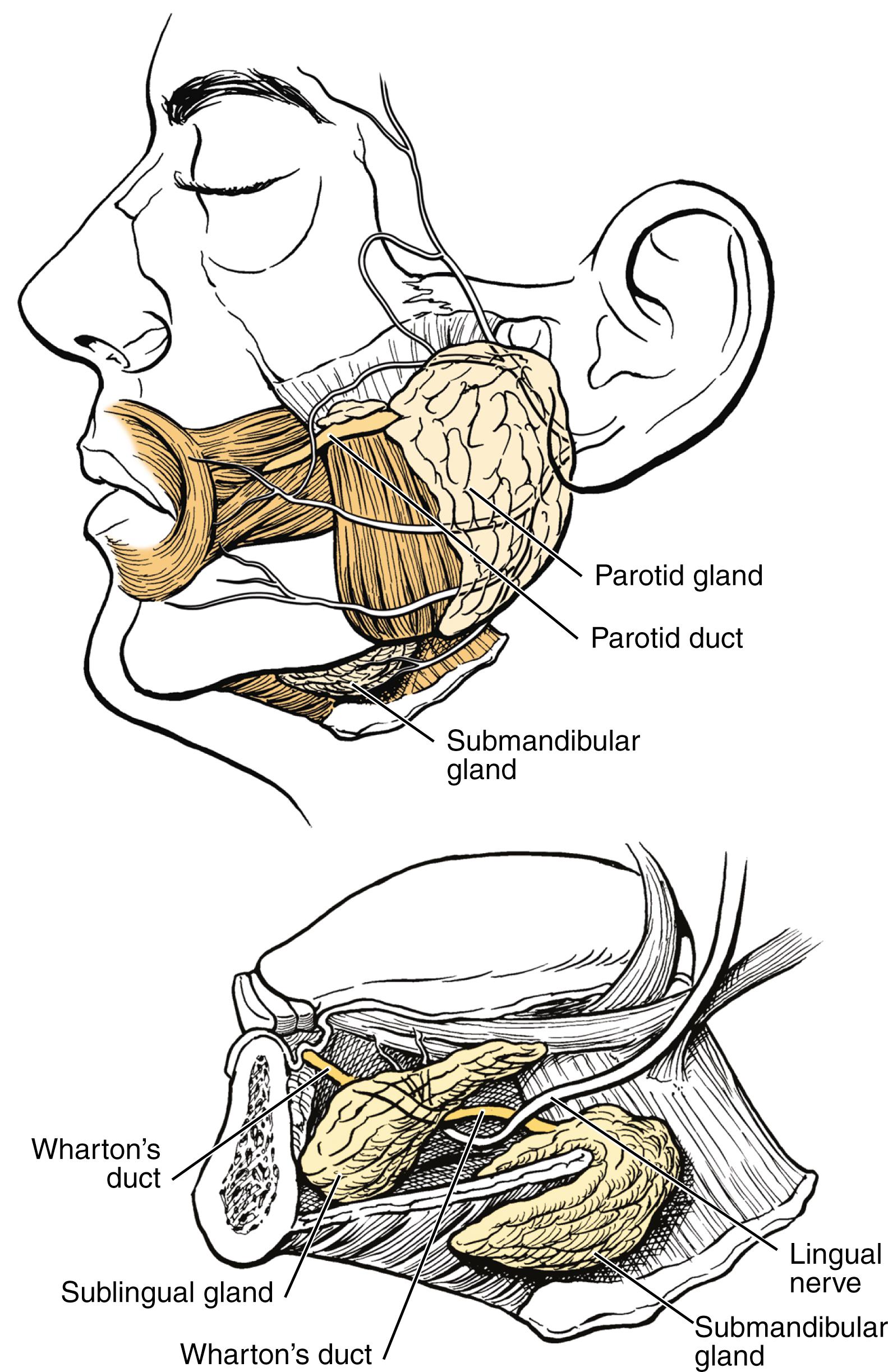
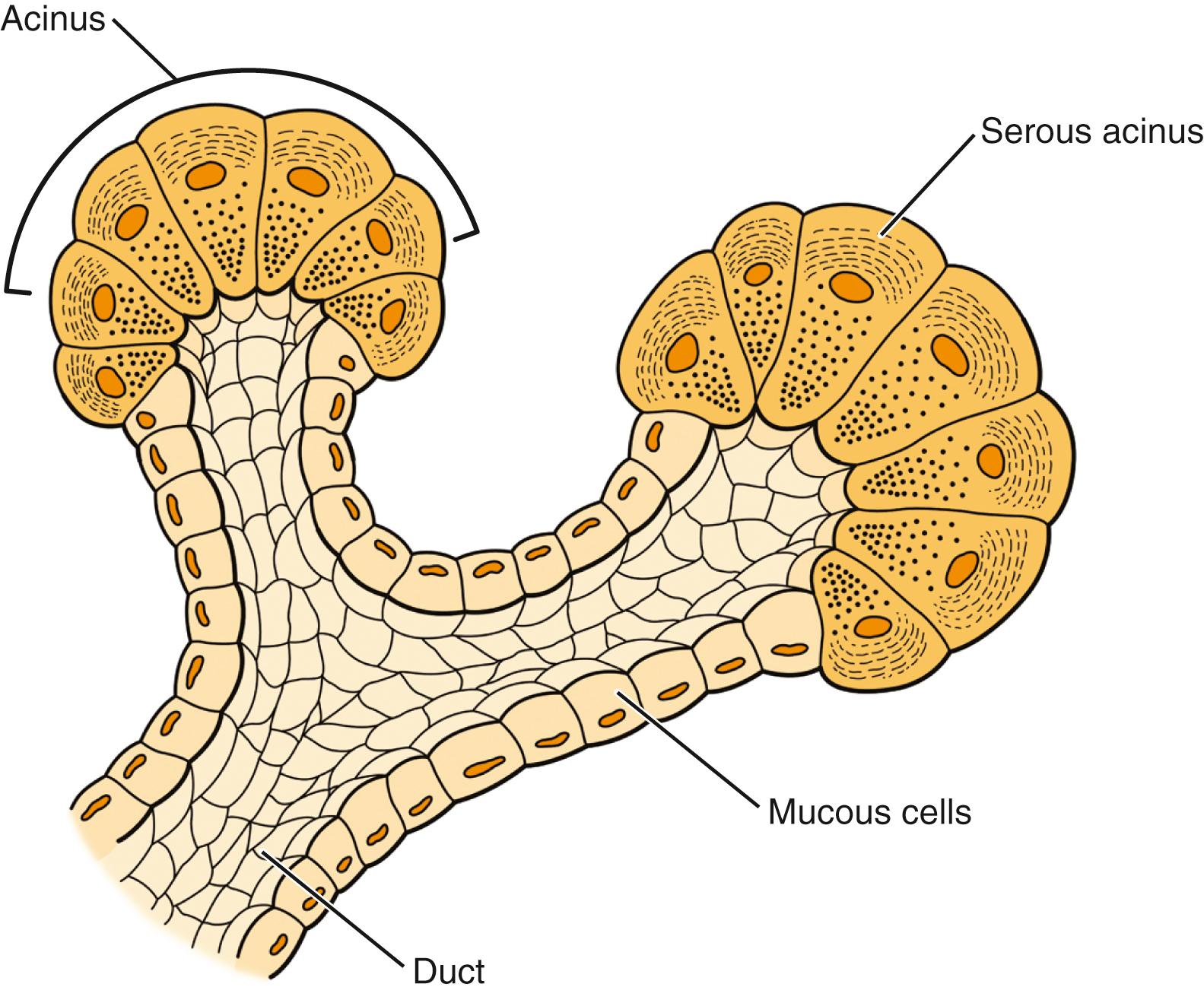
The parotid is the largest major salivary gland and is the first to develop in utero. Rarely, agenesis of the parotid and/or submandibular glands has been reported ( Fig. 24.5 ). , The parotid becomes encapsulated after development of the lymphatic system and is therefore the only salivary gland that contains lymph nodes. It lies between the external auditory canal, the ramus of the mandible, and the mastoid tip and is artificially divided by the facial nerve into a deep and a superficial lobe. It is separated by the stylomandibular ligament from the submandibular gland, and both glands are covered by the superficial portion of the deep cervical fascia. The parotid acinar units and ductal systems drain into a final secretory duct known as the Stensen duct. The latter arises from the anterior border of the parotid gland, courses superficial to the masseter muscle in a direction parallel and inferior to the zygoma, then turns sharply, pierces the buccinators, and enters the oral cavity opposite the second upper molar. Detached accessory parotid glands have been described, located at variable distances from the main gland along the Stensen duct in 21% of cadaver specimens. The Stensen duct is 4 to 7 cm in length and has a variable diameter along its length; histologic studies reveal a mean diameter ranging between 0.5 and 1.4 mm, a narrowing at the middle of the duct, and the smallest diameter at the ostium (0.5 mm).
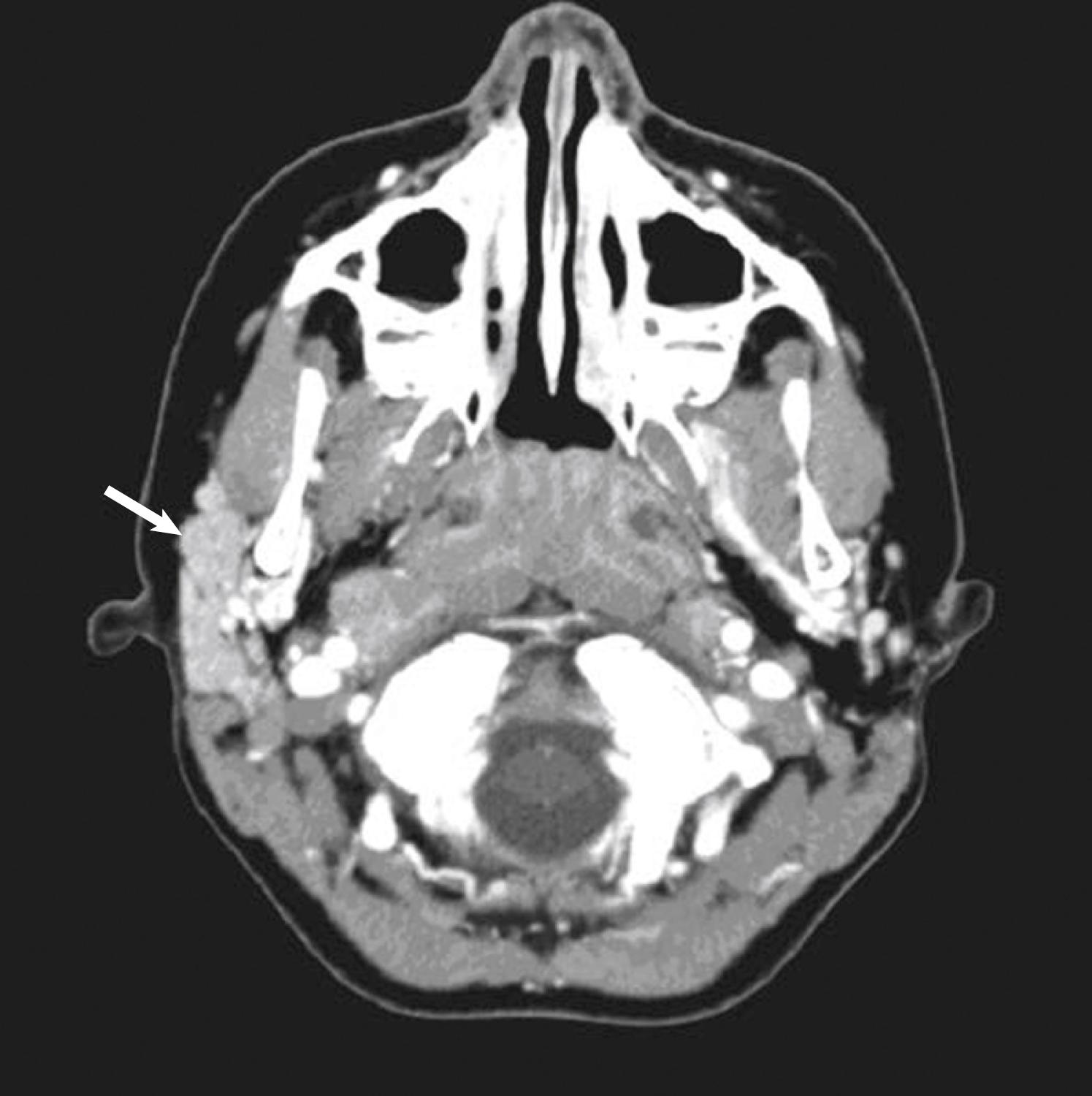
Because the anatomic landmarks are not as well defined in infants and young children, the facial nerve is much more prone to injury during pediatric salivary gland surgery than that in adults. Before complete pneumatization of the mastoid air cells, the facial nerve takes a more abrupt and lateral course after exiting the stylomastoid foramen and can be found just deep to the subcutaneous tissue before entering the parotid gland. Because the parotid gland is not completely developed in children, the facial nerve may be more vulnerable to injury. Finally, the marginal mandibular branch of the facial nerve is located more superiorly in children compared with adults, often taking a superficial course over the mandible. It is only after the development of the mastoid tip and tympanic ring that the facial nerve takes a deeper and more protected position behind the mastoid bone and the tragal cartilage.
The submandibular and sublingual glands are small in young infants and are often anatomically contiguous. Rapid growth of these glands occurs during the first 2 years of life. The submandibular gland is located in the floor of the mouth and consists of a larger superficial part separated from a smaller deep part by the posterior free edge of the mylohyoid muscle. The superficial part rests between the anterior and posterior digastric muscles just below the body of the mandible and is bounded superomedially by the mylohyoid muscle and inferiorly by platysma and the investing layer of the deep cervical fascia. The deep part is located between the mylohyoid and the hyoglossus muscles. Acinar units and ductal systems drain into a single and final secretory duct known as the Wharton duct . The submandibular duct emerges from the medial deep part of the gland and runs anteriorly above the mylohyoid and on the lateral surface of the hyoglossus and genioglossus muscles. It is 5 cm long, has a mean diameter that ranges between 0.5 and 1.5 mm, and opens in the floor of the mouth through a papilla lateral to the tongue frenulum. Its minimum width (0.5 mm) is located at the ostium. The duct has an intricate relation with the lingual nerve (see Fig. 24.3 ). Posteriorly, the lingual nerve lies above the duct; then, as the nerve descends, it crosses the lateral side of the duct and passes below it, winding around its lower border before crossing it medially and ascending toward the genioglossus. The hypoglossal nerve is located anterior, deep, and medial to the submandibular gland. It also courses deep to the Wharton duct and to the digastric tendon.
The sublingual glands lack a capsule and are located in the floor of the mouth above the mylohyoid muscle in the space between the mandible and the genioglossus muscles, immediately below the oral mucosa. They drain directly via several small ducts (ducts of Rivinus) into the floor of the mouth; occasionally some of the ducts collect into a larger common duct known as the Bartholin duct, which empties into the Wharton duct. The sublingual glands are often the source of ranulas, which are mucus-filled swellings in the floor of the mouth.
The remaining upper aerodigestive tract is lined by hundreds of minor salivary glands that lie just deep to the mucosa. The highest concentration of minor glands is in the buccal, lingual, labial, and palatal regions. Each minor gland has a draining duct that opens directly into the mucosa. Occlusion of these ducts can lead to small mucoceles that are frequently found along the lower lip of young children.
Salivary flow is controlled via the autonomic nervous system. The parotid gland receives parasympathetic secretomotor innervation from preganglionic fibers that arise in the inferior salivatory nucleus of the medulla. These fibers travel with the ninth cranial nerve to exit the skull via the jugular foramen. They then leave the glossopharyngeal nerve as the Jacobson nerve and reenter the skull via the inferior tympanic canaliculus. The fibers pass through the middle ear space over the promontory of the cochlea (tympanic plexus) and exit the temporal bone as the lesser petrosal nerve. This nerve exits the middle cranial fossa through the foramen ovale, where the preganglionic fibers synapse in the otic ganglion. The postganglionic fibers travel with the auriculotemporal nerve to supply the parotid gland. The submandibular, sublingual, and minor salivary glands receive parasympathetic secretomotor innervation from preganglionic fibers, which originate in the superior salivatory nucleus in the pons. These fibers leave the brainstem as the nervus intermedius to join with the facial nerve. They then leave the facial nerve with the chorda tympani in the mastoid segment and travel through the middle ear and petrotympanic fissure to the infratemporal fossa. The presynaptic fibers are then carried by the lingual nerve, a branch of the mandibular division of the trigeminal nerve, to synapse in the submandibular ganglion. Postganglionic fibers innervate the submandibular and sublingual glands. Postganglionic sympathetic innervation of the major salivary glands is through the external carotid plexus, which originates from the superior cervical ganglion.
Frey syndrome, also known as gustatory flushing or auriculotemporal nerve syndrome, is characterized by facial skin flushing and sweating that classically occurs in response to gustatory or olfactory stimuli. Its postulated etiology is related to the abnormal regeneration of the parasympathetic fibers that normally innervate the parotid gland, because acetylcholine is the neurotransmitter for both sympathetic and parasympathetic fibers. The traumatized regenerated fibers aberrantly innervate the vessels and sweat glands of the overlying skin, which are normally supplied by sympathetic nerve fibers. In children, Frey syndrome can occur after any local trauma to the parotid area, such as vaginal delivery with forceps, postcondylar fracture or seizure, or parotid surgery or infection (herpes zoster). The latent time required for the development of this condition can vary from days to several years after the insult. Frey syndrome has also been described to occur in a familial pattern in the absence of a history of perinatal trauma. Most children do not require any treatment. In adolescents with severe symptoms, intradermal botulinum toxin injections are safe, effective, and well tolerated.
Saliva is a complex solution composed of mostly water (99%), electrolytes, proteins, and enzymes. The elements of saliva maintain moisture within the oral cavity, lubricate food, inhibit bacterial growth (lysozyme and immunoglobulin [Ig]), and begin the food digestion process (amylase). The amount of saliva secreted ranges between 0.5 and 1.5 L daily, depending on the size of the child. High bicarbonate ion content is responsible for its relatively alkaline pH of 7.4. Secretions from the parotid gland are mostly serous in nature, with a high water content and relatively lower mucin content. In contrast, the submandibular and sublingual gland secretions are mixed (mucous and serous), leading to a more viscous, mucin-rich saliva. Resting salivary secretions are produced predominantly by the submandibular glands (60% to 70% of total saliva). The parotid is the major contributor to stimulated saliva, and salivary flow increases with the sight and smell of food, with chewing and taste sensations, and with esophageal and gastric reflex–mediated responses. Parasympathetic postganglionic cholinergic nerve fibers stimulate the secretion of large amounts of a low-protein serous saliva. On the other hand, sympathetic stimulation of the salivary glands causes the secretion of a small and variable amount of thicker saliva, likely caused by contraction of the myoepithelial cells.
A detailed history—including the onset, duration, severity, and frequency of symptoms—is crucial in the assessment of children with salivary gland disorders. Perinatal salivary gland swelling is more likely to be a congenital lesion, such as hemangioma or a lymphatic or vascular malformation. A gradual painless increase in size suggests a neoplasm, especially in older children. An acute onset of pain and swelling, especially with fever, indicates an inflammatory or infectious process. Ductal obstruction often presents with intermittent and recurrent postprandial swelling of the gland. Painless violaceous lesions of the skin are often seen with atypical mycobacterial infections, which typically affect the preauricular and submandibular areas. A history of cat exposure raises the possibility of cat-scratch disease (CSD), and exposure to sick contacts and vaccination history should be elicited to rule out mumps. The history should assess for the presence of other systemic conditions, and involvement of more than one gland may indicate systemic or autoimmune disease. A history of trauma suggests duct injury or disruption.
Physical examination should note the location, size, mobility, symmetry, tenderness, and consistency of the glands in addition to any overlying skin changes such as erythema, edema, dermal involvement, or presence of a fistula. A complete exam includes bimanual palpation performed with one hand externally and a gloved finger intraorally. The buccal mucosa, oral cavity, and floor of the mouth should be inspected, and the ducts should be palpated for the presence of stones. Signs of trauma related to oral appliances or cheek biting may point to the source of ductal obstruction. Massaging the gland while observing the saliva expressed from the ductal opening can be useful to rule out ductal blockage or to identify pus, therefore confirming the presence of an obstruction or an infection, respectively. Punctal edema with clear saliva is suggestive of viral sialadenitis.
Facial nerve function in all divisions, tongue mobility for hypoglossal nerve function, and general somatic sensation (fifth cranial nerve) should be documented. A salivary gland mass accompanied by facial nerve weakness is highly suspicious for a malignant process. In contrast to those in adults, solid lesions in children are more likely to be malignant; the larger the gland of origin in children, the more likely a tumor will be malignant. A good history and physical examination will guide the need for additional investigations such as laboratory studies and diagnostic imaging.
Laboratory studies may be helpful in narrowing down the differential diagnosis of salivary gland disease. The white blood cell count, if elevated, may confirm an infectious etiology and can also serve for follow-up on the response to treatment. C-reactive protein is a nonspecific marker of inflammation that can also be followed in cases of infections. Mumps serology and amylase levels may be useful in certain cases. Also, when multiple glands are involved, as with bilateral cystic swelling of the parotid glands, investigations for immunosuppression or human immunodeficiency virus (HIV) infection should be considered. Cultures of secretions expressed from the ductal orifice may help in identifying the causative organisms. In cases suspicious for mycobacterial infections, a purified protein derivative skin test and chest radiograph should be done. Serology for sarcoidosis and Sjögren syndrome may occasionally be useful.
Multiple imaging modalities may be helpful for establishing the diagnosis and management plan of salivary gland lesions. Plain radiographs may illustrate radiopaque stones in the salivary gland ducts. However, as much as 20% of submandibular and 80% of parotid duct stones will be radiolucent, which leads to false-negative results on plain films. Phleboliths, atherosclerosis of the lingual artery, and calcified lymphadenopathy will also appear as calcification on plain films and thus complicate their interpretation.
US remains the most helpful test in the pediatric population because it is noninvasive, inexpensive, widely available, and avoids radiation exposure. Many otolaryngologists are currently equipped in their practice setting to use US as part of their clinical assessment of salivary gland and neck pathology. The precision of US for the diagnosis of superficial parotid and submandibular gland lesions is comparable to that of CT or MRI. US can detect as much as 90% of stones greater than 2 mm and can distinguish benign from malignant lesions in the majority of cases. US can also differentiate whether masses are within the gland or extraglandular with a high degree of accuracy. Although the facial nerve is not identified by US, visualization of the intraparotid vasculature helps distinguish the deep from the superficial lobe of the parotid. US is useful to diagnose abscesses and vascular lesions and can also assist in guiding FNA of superficial lesions.
Despite all its advantages, US remains an operator-dependent test and is not an appropriate tool for a complete evaluation of the nature and extent of salivary gland masses; cross-sectional imaging with CT and/or MRI is often necessary. These modalities are needed to evaluate deep parotid lesions, parapharyngeal extension, retropharyngeal and deep cervical lymphadenopathies, and skull base extension. CT is often the test of choice in inflammatory and obstructive conditions such as sialadenitis, ductal stones or stenosis, ranulas, and abscesses. It can provide great anatomic detail and assist in surgical planning. Imaging is performed both before and after administration of intravenous contrast with both soft tissue and bone algorithms. CT can also be useful in solid masses to identify any erosion of the surrounding bone. Although noncontrast CT is useful in cases of salivary gland stones, intravenous contrast is needed when information about vascularity or abscess formation is desired. Despite the ionizing radiation, the CT scan has the advantage of being a short procedure, as opposed to MRI, and can be done without the need for sedation in most cases. Currently, cone beam CT is being used more frequently because it provides relatively high resolution of bony structures with a lower dose of radiation.
MRI is the test of choice in cases suspicious for an underlying neoplasm and in masses of the parapharyngeal space. It gives excellent soft tissue detail and the ability to identify tumor margin, extent, depth of infiltration, involvement of the facial nerve, and perineural spread. Standard axial T1- and T2-weighted images reveal tumor margins. Coronal, fat suppression, and gadolinium-enhanced images can help identify perineural spread. Flow voids assist in determining the nature of vascular malformations; high-flow lesions, such as arteriovenous malformations and hemangiomas, can easily be delineated from low-flow lesions such as lymphangiomas. Newer MR techniques can help delineate benign from malignant processes using dynamic contrast or diffusion-weighted methods. A principal advantage of MRI versus CT in children is the absence of ionizing radiation; however, MRI remains a lengthy procedure that requires sedation or general anesthesia to obtain good-quality images. Also, MRI is more expensive and may be less readily available than other imaging modalities.
Traditional sialography consists of injecting contrast material into the Stensen or Wharton duct to detect duct stricture, stenosis, sialectases, or sialoliths. Sialography has been the gold standard for the evaluation of sialadenitis but is contraindicated in acute sialoadenitis. It is also rarely used for sublingual imaging because of the small ducts of Rivinus that open directly into the floor of the mouth and make the overview difficult.
Sialography is less feasible in uncooperative children because it requires cannulation of the duct. Another disadvantage is that it uses ionizing radiation. Sialography is being gradually replaced in many institutions by noninvasive imaging techniques. MR sialography allows for a precise morphologic evaluation of the salivary ducts up to second- and third-order branches without the need for duct cannulation. Also, it does not expose patients to ionizing radiation or contrast agents, and the examination may be carried out even in the setting of acute inflammation of the salivary gland. First described by Lomas in 1996 using the single-shot rapid acquisition with relaxation enhancement sequence, MR sialography has been validated by several studies using a number of different pulse sequences, including modified rapid acquisition with relaxation enhancement, fast spin-echo, constructive interference in steady state, and half-Fourier acquisition single-shot turbo spin echo. ,
Nuclear imaging studies may be useful in selected cases. Scintigraphy is a diagnostic test wherein radioisotopes are administered and taken up by the organ of interest, and the emitted radiation is captured by external gamma cameras to form two-dimensional images. Salivary gland scintigraphy with technetium-99m (99mTc) pertechnetate can be used to assess the parenchymal and excretory function of all major salivary glands. After administering a single intravenous injection—which is well tolerated—the uptake, concentration, and excretion of the tracer can be measured. A stimulated excretion fraction that measures the percent of trapped saliva emptied into the oral cavity in response to a sialogogue stimulus can also be calculated.
Net counts are those that remain in the salivary gland after subtraction of nonspecific background counts.
Scintigraphy can be useful to assess the residual function of the salivary glands after duct ligation or duct relocation surgery. It can also be helpful in the assessment of specific autoimmune and inflammatory diseases of the salivary glands such as Sjögren syndrome and those that result from radioactive iodine treatment and head and neck radiation therapy.
The radionuclide salivagram is a sensitive and specific imaging method for detecting tracheobronchial aspiration of oropharyngeal contents and secretions. The salivagram is particularly useful in patients who are unable to cooperate with or swallow adequately to allow a videofluoroscopic swallow assessment. Sodium pertechnetate is absorbed by the oral and gastric mucosa and therefore cannot be used for the salivagram. Rather, a small drop of saline (0.1 mL) that contains 99mTc-labeled sulfur colloid or 99mTc-diethylene triamine pentaacetic acid is placed sublingually or on the back of the tongue. Dynamic images are recorded and chest images are obtained at the end of the study. Salivary aspiration is confirmed with the detection of positive radioactivity in the tracheobronchial tree. If aspiration is identified, continued imaging may reveal whether the aspirated tracer is spontaneously cleared from the airway. Patients who are able to clear their airways after aspiration have a better prognosis. In a study of children with severe cerebral palsy that compared three imaging modalities with document aspiration, the salivagram was the most frequently positive. It was followed by barium videofluoroscopy, whereas the milk scan was the least useful.
Become a Clinical Tree membership for Full access and enjoy Unlimited articles
If you are a member. Log in here